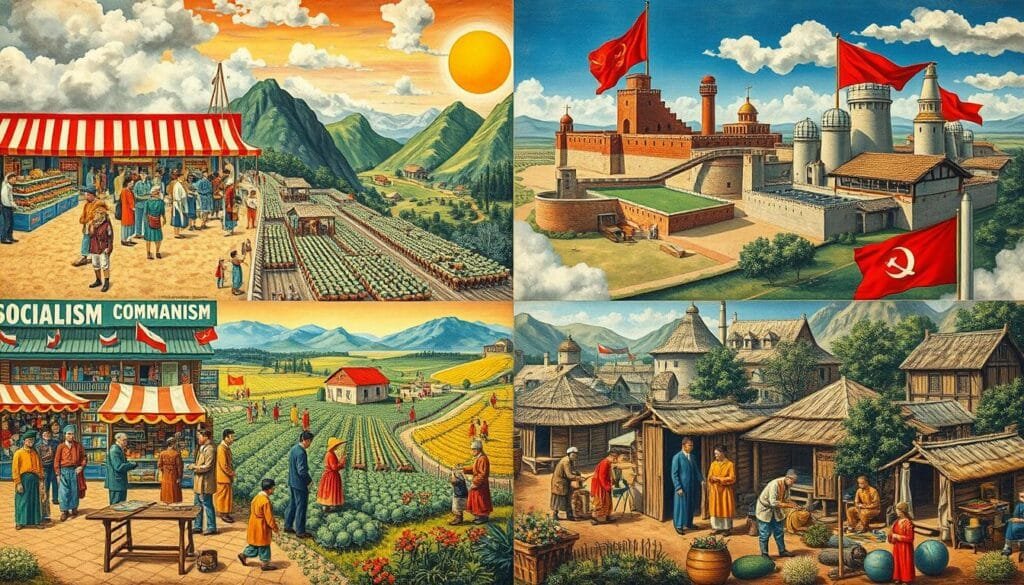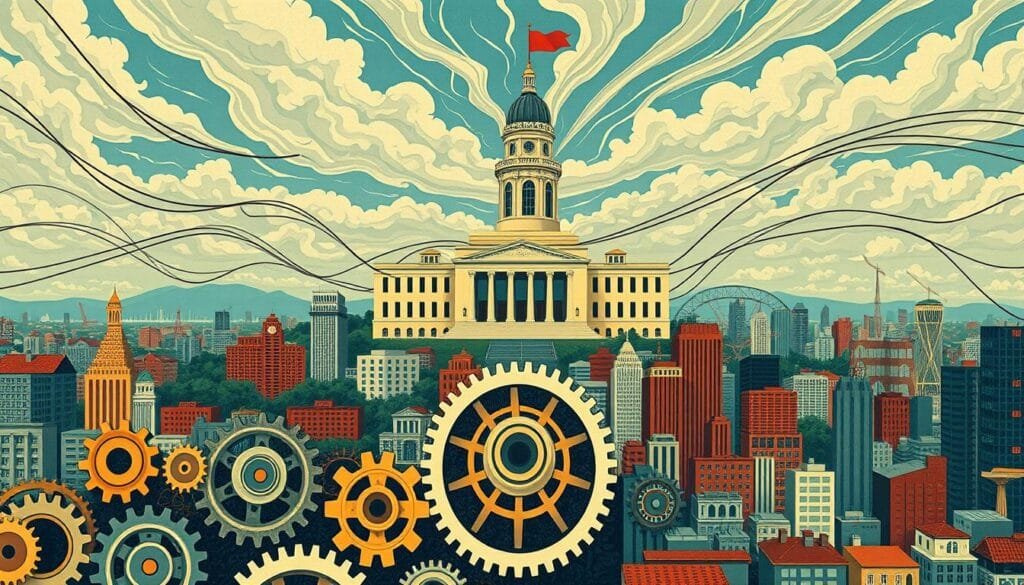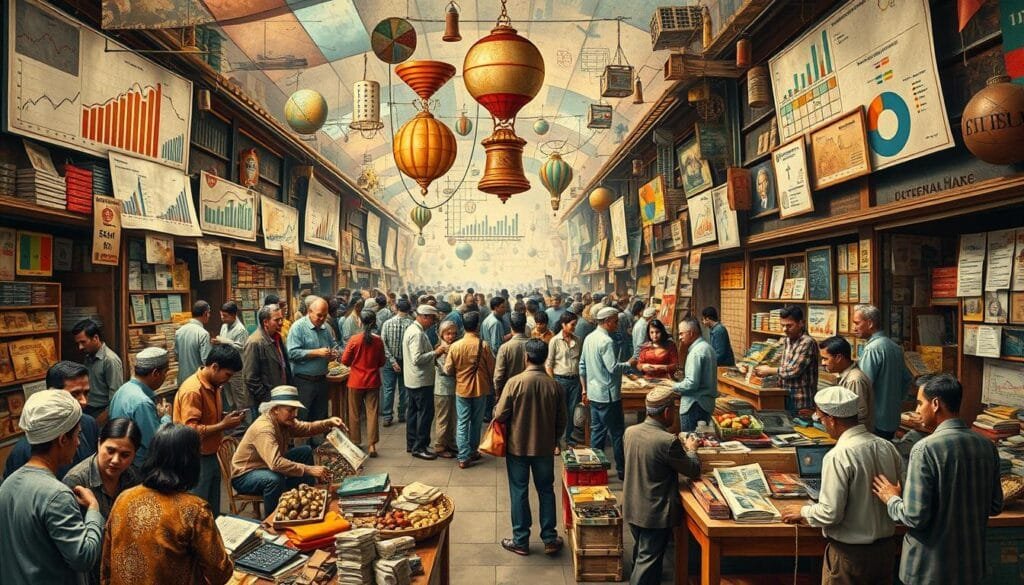Have you wondered why some countries do well and others don’t? It’s because of their economic systems. An economic system is key to organizing and sharing resources, services, and goods. It affects everything in a society or area, from what people buy to what is made.
This way of looking at things shows how crucial economic systems are. They impact our daily lives and the overall economy. For example, in 2016, Canada’s workforce was 19.4 million people. Canada is huge, covering 9.99 million square kilometers. This shows how dividing work and specializing is important for a country’s economy. Adam Smith talked about this using pin making as an example.
But it’s not just about making things. How economic systems operate influences efficiency in many areas. This includes health care, engineering, and business. Knowing how these systems work helps us understand a lot.
Key Takeaways
- The structure and function of an economic system profoundly affect a society’s overall economic health.
- Specialization increases efficiency and productivity across all sectors, from car manufacturing to healthcare.
- A deeper understanding of why the system of economics is crucial helps individuals make informed financial decisions.
- Resources allocation, government policies, and consumer behavior significantly influence how economic systems work.
- Macroeconomic indicators like GDP, inflation rates, and employment statistics help assess an economy’s condition.
The Fundamentals of Economic Systems
Economic systems are the ways communities or governments handle and share resources, services, and goods. It’s key to know what they are to understand how societies manage their economies.
Definition of Economic Systems
Economic systems describe how societies allocate resources and choose production and distribution methods. They tackle three main questions: What to produce, how to do it, and who gets it. Various economic systems, including traditional, command, and market economies, have different answers.
Market-oriented mixed economies find a middle ground between private business and government control. This mix includes models like the Nordic model and dirigisme. Economic systems change over time, moving from 16th-century mercantilism to modern capitalism and socialism.
Purpose and Function of Economic Systems
Economic systems aim to efficiently use resources and manage production. They help organize society to meet people’s needs. The function of these systems highlights their role in promoting welfare and productivity.
| Economic System | Characteristics | Historical Examples |
|---|---|---|
| Traditional Systems | Relies on communal approval, often tied to cultural practices | Native American tribal economies, Ancient agrarian communities |
| Command Economies | Centralized control, mobilization of resources | Soviet Union, the construction of the Great Wall of China |
| Market Economies | Encourages competition, private ownership | United States, United Kingdom |
| Mixed Economies | Combination of public and private ownership | Nordic countries, France (dirigisme) |
History shows us models from mercantilism promoting colonialism to today’s mixed economies. These show how state control and market freedom can blend. In market economies, consumer choices greatly impact what is made.
In short, economic systems are complex but key to fostering society’s growth. They blend planning and welfare to use resources well. Each system, from traditional to market-driven, plays a role in sustainable development.
Types of Economic Systems
Economic systems differ worldwide, shaped by how they manage resources and activities. Exploring these systems helps us understand their effects on people and society.

Traditional Economic Systems
Traditional economies are rooted in the past. They are common in less-developed, rural areas where farming is vital. These systems depend on old customs and proven methods. Their goal is to support the community, not to make extra goods for trade.
Command Economic Systems
In command economies, the government makes all the economic decisions. These are seen in countries with precious resources like oil. The government plans everything, including what to produce and the prices. But, people have criticized socialism, a kind of command economy, for not being efficient or fair.
Market Economic Systems
Market economies are based on supply and demand with little government control. They grow through competition and free choice. Here, private ownership and personal freedom are crucial. This system leads to more growth and new ideas, thanks to the market’s natural forces.
Mixed Economic Systems
Mixed economies combine command and market systems. They aim to get the best of both, with government rules and a strong private sector. Countries like Canada and Sweden use this model. They make sure people are taken care of while still encouraging economic growth and activity. This approach tries to be fair and efficient by using the strengths of both systems.
Factors Influencing Economic Systems
Several key factors shape how economic systems operate and succeed. These include how resources are shared, government policies, consumer habits, and global trade. Knowing about these factors helps understand how different economies work and change.
Resources Allocation
How resources are allocated is key to using inputs to efficiently produce outputs. Market economies rely on supply and demand for this. Command economies have central planners making these choices. This affects how well economies compete and satisfy consumers.
In the early 1980s, China moved from a command system to one more market-based. This change led to a 42% rise in agricultural production. It shows how adjusting resource distribution can bring about major economic gains.
Government Policies

Government policies can boost or block economic progress. For instance, the U.S. spent over $2 trillion on social services in 2011. This spending impacted economic stability and confidence among consumers. In 2021, President Joe Biden released 50 million gallons of oil to reduce gas prices. This move shows how government actions can steady markets during ups and downs.
In command economies like North Korea, the government dictates production and pricing. Yet, North Korea has started some market reforms in agriculture. This mixes command and market economy traits.
Consumer Behavior
What consumers want influences market economies greatly. Demand decides which goods and services are produced. It can change due to various reasons, like changes in income, preferences, or the economy’s state. For example, the Consumer Price Index in the U.S. rose by 2.9% from the year before as of July 2024. It shows changing consumer spending habits.
In stricter regimes, the underground economy shows consumer habits. In Cuba, about 95% of people take part in the underground economy. It highlights how consumer needs can shape economic activities, even unofficially.
Trade and Globalization
Global trade changes local economies by bringing in competition and chances for growth. A country’s economy is deeply affected by its trade balance, which comes from import and export actions. For example, in 2023, the U.S. had a $779.8 billion trade deficit. This situation impacted its production and job market.
Globalization allows for the sharing of ideas, technology, and funds. It influences trends in goods and services worldwide. Countries that embrace global trade can improve their economies and create more chances for their people.
Understanding the factors that influence economies, from resource sharing to the effect of government policies, is very important. Different economies use these factors in their own ways. This shapes their progress and how they grow. For more on how economies operate, you can check out further information on economic systems.
| Key Factors | Examples | Effect on Economy |
|---|---|---|
| Resource Allocation Strategies | China’s agricultural reforms (1980s) | Increased production efficiency |
| Government Policies | U.S. social services spending (2011) | Economic stability and consumer confidence |
| Consumer Behavior | Consumer Price Index (U.S., 2024) | Adjustments in market demand |
| Trade and Globalization | U.S. trade deficit (2023) | Impact on domestic production |
Branches of Economics within Different Economic Systems
Understanding different economic branches inside various systems is key. They help us get how global markets work. This part covers applied economics, macroeconomics, and microeconomics.
Applied Economics
Applied economics uses theory to solve real economic problems. It helps make business and policy choices by applying models. For example, government economists use it to create policies impacting the economy. This makes a bridge between theory and practical use.
Macroeconomics
Macroeconomics looks at big economic factors affecting countries and the world. It includes national income, GDP, jobs, and trade. The Consumer Price Index (CPI) tracks retail price changes, showing inflation. GDP measures a country’s economic health. These facts are crucial for making good policies and maintaining economic stability.
Microeconomics
Microeconomics deals with actions at the individual and business levels. It studies market dynamics like supply and demand that affect prices and consumption. It shows how things like consumer spending, which is most of the U.S. GDP, affect the economy. Understanding these helps businesses make smart choices and stay flexible in the market.
Importance of Understanding Why is the System of Economics
Understanding how economic systems work is very important. It helps people make smart choices in their daily lives. Also, it helps those in charge to create strong economic rules. Knowing about economics matters for many reasons. These include job opportunities, understanding big economic trends, and creating a smart voting public.
Durham University showed how valuable an economics degree can be. Its BA (Hons) in Economics ranked 14th in the UK, according to the Guardian University League Table in 2020. The HESA survey from 2016/17 found Durham’s program was the best for grads getting jobs or studying more. This proves that learning about economics is useful.
Economic knowledge is very important, not just in school. Economists provide important forecasts and information. This info helps both governments and businesses make decisions. They use detailed data analysis and prediction models. Understanding economic theories is critical. Especially for success in areas like banking, finance, accounting, government, and consultancy.

About 44 percent of high school students take an economics class before they graduate. However, only 16 states require a class in economics. This shows that not everyone has the chance to learn about this subject. Because of this, less than half of students can answer basic economics questions on tests correctly.
Surveys show that 83 percent of people think their grasp of economic issues is weak. This shows a big need for better understanding of economics. To meet this need, places like Durham’s International Foundation Year offer deep programs in Business, Economics, Accounting, and Finance.
Economics combines ideas from politics, history, psychology, and sociology. This gives a full view of how economic systems work. With this wide view, students and workers can better face and solve today’s economic issues.
Conclusion
As we wrap up our journey into economic systems, it’s clear they hugely impact the world and our lives. We delved into traditional, command, market, and mixed systems. Each system has its way of working, advantages, and areas it falls short in, shown through indicators like GDP and job stats.
In capitalist settings, we saw how GDP, inflation, and the Gini Coefficient are key to understanding the economy. These factors show the balance between spending by people and economic expansion. In contrast, command economies use plans and goals set by the government. They focus on resource use and output to judge productivity and quality of life. The government decides on plans and budgets, showing they have major control.
Traditional economies are all about surviving, community, and using resources wisely. They shed light on how societies keep traditions and knowledge alive. Mixed economies mix freedom in the market with government checks, like subsidies and rules. Research shows that government help affects 95% of modern economies. This kind of spending by the public sector helps the economy grow and makes income more equal.
Understanding these economic systems helps us get the bigger picture of the world’s economy. It adds to our learning and lets us take part in economic talks and changes. By knowing the details of these systems, we can support policies. These should encourage growth and take care of people’s well-being.
FAQ
What is the importance of an economic system?
An economic system is key because it decides how a nation uses its resources and creates wealth. It shapes the economy and greatly affects the living standards of its people.
How do economic systems work?
Economic systems set rules for decisions on production and distribution. They use markets, government, and culture to guide economic activity.
What are the main types of economic systems?
There are four main economic systems. These include traditional, command, market, and mixed systems. Each one has unique ways of handling resources and activities.
What is a traditional economic system?
A traditional system is built on customs and beliefs. It uses inheritance and social roles to allocate resources. Activities focus on family or community needs.
What is a command economic system?
In a command system, the government decides everything about the economy. This covers production, prices, and distribution. Socialism and communism are examples.
What characterizes a market economic system?
A market system is ruled by supply and demand with minimal government input. It allows individuals freedom in economic choices. This is known as capitalism.
What is a mixed economic system?
A mixed system blends market and command system elements. Both government and private sector share decision-making. It aims for the strengths of both systems.
What factors can influence economic systems?
Factors like resource use, government policies, consumer actions, and global trade shape economic systems. They affect how systems change and perform.
How do resources get allocated in different economic systems?
Resource allocation changes with the economic system. In market economies, supply and demand rule. Governments decide in command economies. Tradition guides in traditional economies.
What impact do government policies have on economic systems?
Government actions shape economies through rules, subsidies, taxes, and trade deals. These influence a nation’s economic growth and wealth spread.
How does consumer behavior affect economic systems?
Consumer choices drive demand, affecting production and prices. This influences the economy’s health and market changes.
What role does trade and globalization play in economic systems?
Trade and globalization widen markets and boost growth. They allow goods, services, and technology exchange, linking economies worldwide.
What are the branches of economics within different economic systems?
Economics splits into branches like applied, macro, and microeconomics. Each studies different economic levels and interactions, offering a broad view of economic operations.
What is applied economics?
Applied economics uses theories to solve real-world issues. It helps make decisions in business, policy, and finance.
What does macroeconomics study?
Macroeconomics looks at the big picture of an economy. It examines major issues like inflation and growth at national or global scales.
What is microeconomics?
Microeconomics focuses on the choices of individuals and firms. It explores how they use resources, and it deals with supply, demand, and price.
Why is understanding economic systems important?
Knowing economic systems aids in making smart finance and business choices. It helps understand how economies work and the impact of different factors on growth.
